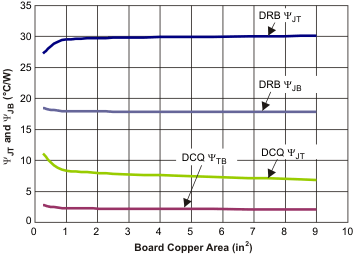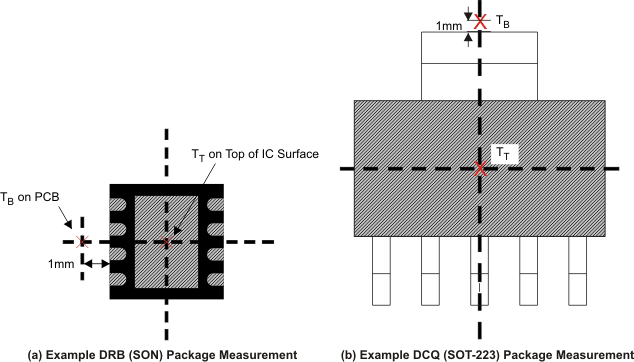SLVS350J October 2002 – May 2019 TPS795
PRODUCTION DATA.
- 1 Features
- 2 Applications
- 3 Description
- 4 Revision History
- 5 Pin Configuration and Functions
- 6 Specifications
- 7 Detailed Description
- 8 Application and Implementation
- 9 Power Supply Recommendations
- 10Layout
- 11Device and Documentation Support
- 12Mechanical, Packaging, and Orderable Information
Package Options
Mechanical Data (Package|Pins)
Thermal pad, mechanical data (Package|Pins)
- DRB|8
Orderable Information
10.1.4 Estimating Junction Temperature
Using the thermal metrics ΨJT and ΨJB, as shown in Thermal Information, the junction temperature can be estimated with corresponding formulas (given in Equation 6). For backwards compatibility, an older θJC,Top parameter is also listed.

where
- PD is the power dissipation shown by Equation 5
- TT is the temperature at the center-top of the IC package
- TB is the PCB temperature measured 1 mm away from the IC package on the PCB surface (see Figure 31)
NOTE
Both TT and TB can be measured on actual application boards using a thermo‐gun (an infrared thermometer).
For more information about measuring TT and TB, see the application note SBVA025, Using New Thermal Metrics, available for download at www.ti.com.
As shown in Figure 30, the new thermal metrics (ΨJT and ΨJB) have little dependency on board size. That is, using ΨJT or ΨJB with Equation 6 is a good way to estimate TJ by simply measuring TT or TB, regardless of the application board size.
 Figure 30. ΨJT and ΨJB vs Board Size
Figure 30. ΨJT and ΨJB vs Board Size For a more detailed discussion of why TI does not recommend using θJC(top) to determine thermal characteristics, see the application report SBVA025, Using New Thermal Metrics, available at www.ti.com.
For further information, see the application report SPRA953, IC Package Thermal Metrics, also available on the TI website.
 Figure 31. Measuring Point for TT and TB
Figure 31. Measuring Point for TT and TB